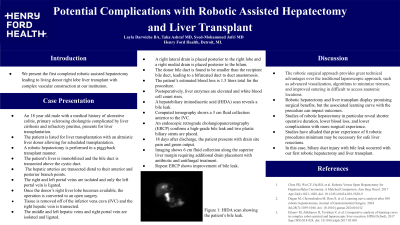Sunday Poster Session
Category: Liver
P1275 - Potential Complications With Robotic-Assisted Hepatectomy and Liver Transplant
Sunday, October 27, 2024
3:30 PM - 7:00 PM ET
Location: Exhibit Hall E

Has Audio
- LD
Layla Darwiche, BA
Henry Ford Health
Detroit, MI
Presenting Author(s)
Layla Darwiche, BA, Taha Ashraf, MD, Syed-Mohammed Jafri, MD
Henry Ford Health, Detroit, MI
Introduction: We present the first completed robotic assisted hepatectomy leading to living donor right lobe liver transplant with complex vascular construction at our institution.
Case Description/Methods: An 18 year old male with a medical history of ulcerative colitis, primary sclerosing cholangitis complicated by liver cirrhosis and refractory pruritus, presents for liver transplantation. The patient is listed for liver transplantation with an altruistic liver donor allowing for scheduled transplantation.
A robotic hepatectomy is performed in a piggyback transplant manner. The patient’s liver is immobilized and the bile duct is transected above the cystic duct. The hepatic arteries are transected distal to their anterior and posterior branch points. The right and left portal veins are isolated and only the left portal vein is ligated. Once the donor’s right liver lobe becomes available, the operation is converted to an open surgery. Tissue is removed off of the inferior vena cava (IVC) and the right hepatic vein is transected. The middle and left hepatic veins and right portal vein are isolated and ligated. A right lateral drain is placed posterior to the right lobe and a right medial drain is placed posterior to the hilum. The donor bile duct is found to be smaller than the recipient bile duct, leading to a bifurcated duct to duct anastomosis. The patient’s estimated blood loss is 1.5 liters total for the procedure.
Postoperatively, liver enzymes are elevated and white blood cell count rises. A hepatobiliary iminodiacetic acid (HIDA) scan reveals a bile leak. Computed tomography shows a 3 cm fluid collection anterior to the IVC. An endoscopic retrograde cholangiopancreatography (ERCP) confirms a high-grade bile leak and two plastic biliary stents are placed.
18 days after discharge, the patient presents with drain site pain and green output. Imaging shows 6 cm fluid collection along the superior liver margin requiring additional drain placement with antibiotic and antifungal treatment. Repeat ERCP shows improvement of bile leak.
Discussion: Robotic hepatectomy and liver transplant display promising surgical benefits, but the associated learning curve with the procedure can impact outcomes. Studies of robotic hepatectomy reveal shorter operative duration, lower blood loss, and lower complications with more experience. In this case, biliary duct injury with bile leak occurred with our first robotic hepatectomy and liver transplant.
Disclosures:
Layla Darwiche, BA, Taha Ashraf, MD, Syed-Mohammed Jafri, MD. P1275 - Potential Complications With Robotic-Assisted Hepatectomy and Liver Transplant, ACG 2024 Annual Scientific Meeting Abstracts. Philadelphia, PA: American College of Gastroenterology.
Henry Ford Health, Detroit, MI
Introduction: We present the first completed robotic assisted hepatectomy leading to living donor right lobe liver transplant with complex vascular construction at our institution.
Case Description/Methods: An 18 year old male with a medical history of ulcerative colitis, primary sclerosing cholangitis complicated by liver cirrhosis and refractory pruritus, presents for liver transplantation. The patient is listed for liver transplantation with an altruistic liver donor allowing for scheduled transplantation.
A robotic hepatectomy is performed in a piggyback transplant manner. The patient’s liver is immobilized and the bile duct is transected above the cystic duct. The hepatic arteries are transected distal to their anterior and posterior branch points. The right and left portal veins are isolated and only the left portal vein is ligated. Once the donor’s right liver lobe becomes available, the operation is converted to an open surgery. Tissue is removed off of the inferior vena cava (IVC) and the right hepatic vein is transected. The middle and left hepatic veins and right portal vein are isolated and ligated. A right lateral drain is placed posterior to the right lobe and a right medial drain is placed posterior to the hilum. The donor bile duct is found to be smaller than the recipient bile duct, leading to a bifurcated duct to duct anastomosis. The patient’s estimated blood loss is 1.5 liters total for the procedure.
Postoperatively, liver enzymes are elevated and white blood cell count rises. A hepatobiliary iminodiacetic acid (HIDA) scan reveals a bile leak. Computed tomography shows a 3 cm fluid collection anterior to the IVC. An endoscopic retrograde cholangiopancreatography (ERCP) confirms a high-grade bile leak and two plastic biliary stents are placed.
18 days after discharge, the patient presents with drain site pain and green output. Imaging shows 6 cm fluid collection along the superior liver margin requiring additional drain placement with antibiotic and antifungal treatment. Repeat ERCP shows improvement of bile leak.
Discussion: Robotic hepatectomy and liver transplant display promising surgical benefits, but the associated learning curve with the procedure can impact outcomes. Studies of robotic hepatectomy reveal shorter operative duration, lower blood loss, and lower complications with more experience. In this case, biliary duct injury with bile leak occurred with our first robotic hepatectomy and liver transplant.
Disclosures:
Layla Darwiche indicated no relevant financial relationships.
Taha Ashraf indicated no relevant financial relationships.
Syed-Mohammed Jafri: Gilead, Takeda, Abbvie, Intercept, VectivBio – Advisor or Review Panel Member, Speakers Bureau.
Layla Darwiche, BA, Taha Ashraf, MD, Syed-Mohammed Jafri, MD. P1275 - Potential Complications With Robotic-Assisted Hepatectomy and Liver Transplant, ACG 2024 Annual Scientific Meeting Abstracts. Philadelphia, PA: American College of Gastroenterology.
